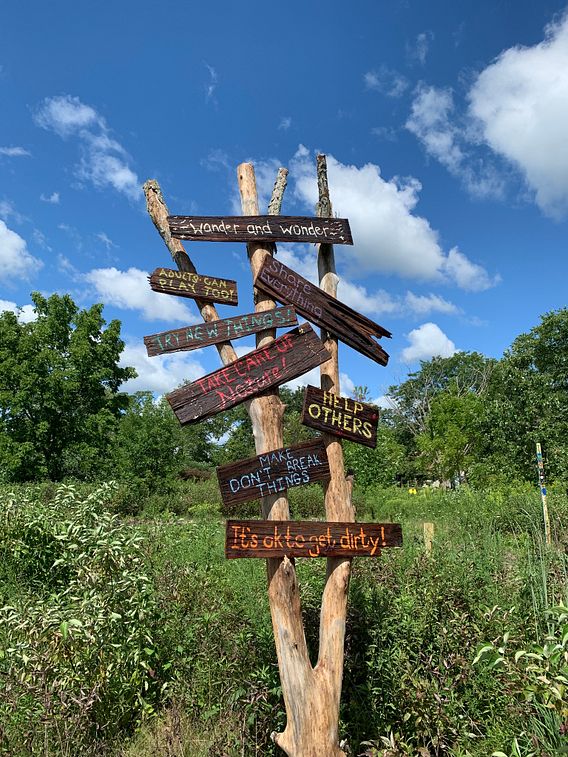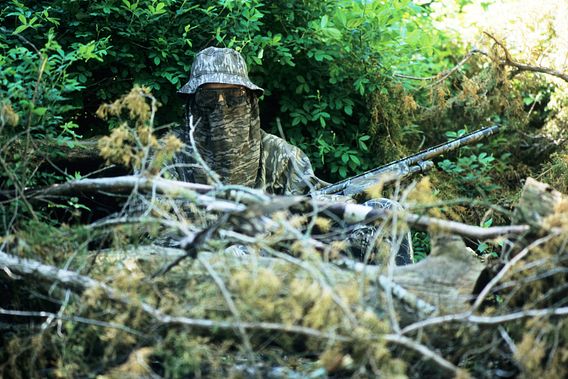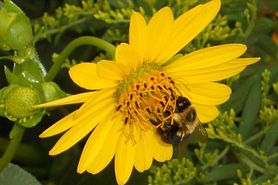Head Outdoors for Inspiration
Time spent outside proves invaluable to body and mind
Kathryn A. Kahler and Andrea Zani
 DNR FILESWords of encouragement await visitors to the new outdoor Nature Explore Classroom at Richard Bong State Recreation Area near Burlington.
DNR FILESWords of encouragement await visitors to the new outdoor Nature Explore Classroom at Richard Bong State Recreation Area near Burlington.“Come to the woods, for here is rest,” John Muir once said. “There is no repose like that of the green deep woods."
The Scottish-born Muir, who spent his teen years near Portage and attended UW-Madison, ranks with history’s most noted conservationists. His writings and advocacy in the late 1800s were instrumental in the creation of U.S. national parks, among other accomplishments.
Without question, Muir fully understood the importance and positive influence of the outdoors. But he was far from alone in doing so.
More than a century ago, writer Henry David Thoreau philosophized about the power of his natural surroundings in “Walden, or Life in the Woods.”
“Live in each season as it passes,” he wrote. “Breathe the air, drink the drink, taste the fruit, and resign yourself to the influence of the earth."
The restorative power of nature and the outdoors has been touted by cultures across the globe for centuries as a means of healing body, mind and spirit. Philosophers and writers — not to mention our own mothers — have long implored us to play outside and discover nature’s inspiration.
More recently, that common-sense guidance is backed by scientific studies showing measurable health benefits provided by something as simple as a walk in the woods.
A 2018 study by the U.K.’s University of East Anglia gathered data from more than 290 million people worldwide. The report found that people with access to greenspace and the outdoors had measurable health benefits including reduced risk of type 2 diabetes, cardiovascular disease, premature death, preterm birth, stress and high blood pressure.
Other studies also have shown the physical benefits of the outdoors — reduced heart rate and inflammation, enhanced vision, cancer prevention, increased energy, weight control — and mental paybacks such as improved memory, focus and creativity, plus reduced depression and anxiety.
Time spent outdoors helps to improve sleep, sleep duration and self-esteem, research shows, and it may boost the immune system. In short, time spent outside is instrumental in maintaining our physical and mental health.
OUTDOORS IN A CRISIS
The abiding idea that the outdoors are essential to well-being has been reinforced in recent months even as Wisconsin, like everywhere, has dealt with unprecedented challenges in the face of COVID-19.
As residents adjusted to new normals of social distancing to mitigate the deadly coronavirus, the Department of Natural Resources was faced with a difficult question in its efforts to ensure outdoor experiences — what to do with state parks and other public properties.
 THOMAS MEYERLooking for pretty scenery, fresh air and overall health benefits? Outdoor places like Sauk County's McGilvra Woods State Natural Area deliver.
THOMAS MEYERLooking for pretty scenery, fresh air and overall health benefits? Outdoor places like Sauk County's McGilvra Woods State Natural Area deliver.First, there was Gov. Tony Evers’ March 12 declaration of a public health emergency, followed by the March 24 “Safer at Home” order — eventually extended into May — designed to help keep COVID-19 in check statewide. The order acknowledged the importance of being outdoors and allowed it as an “essential” function “to engage in outdoor activity, including visiting public and state parks, provided individuals comply with Social Distancing Requirements.”
Initially, all state parks were open with admission fees waived, though visitor centers and campgrounds were closed and group gatherings put on hold. While following the “Safer at Home” order, the DNR recognized the positive health influence of spending time outdoors — especially as a way in itself to help people deal with the stress of the coronavirus crisis.
“We recognize that spending time outdoors benefits both physical and mental health. Getting outdoors can also help relieve stress, especially during this public health emergency,” DNR Secretary Preston D. Cole said. “A quiet walk does wonders to reduce our anxieties.”
As the weather improved and people increasingly began heading outdoors, it eventually became apparent that proper social distancing was not occurring at some locations given the sheer number of visitors seeking to enjoy the parks.
On April 9, at the direction of Gov. Evers, the DNR announced closures effective the following day of more than three dozen state parks, forests and recreation areas that had seen increased attendance, some in record numbers. Temporarily closing certain properties, mainly in the more densely populated southern regions of the state, was deemed necessary in continued efforts to keep the public safe from COVID-19.
“We know there are benefits to getting outdoors. But not doing this would put people’s lives at risk,” Secretary Cole said. “In order to protect the public, this is a necessary step.”
The DNR worked to continue striking the right balance between outdoor opportunities and safety. In late April, following guidance from Gov. Evers’ Badger Bounce Back Plan to reopen Wisconsin, the agency announced it would again welcome visitors to most state properties beginning May 1, but with regular fees reinstated and predetermined capacity limitations, especially at popular spots, to ensure social distancing and safety.
Other safety precautions also were put into place including selling park admission stickers by telephone and eventually online to limit in-person interaction with park staff, adjusting hours at some properties and reserving Wednesdays each week for property maintenance without visitors. A few properties remained closed, as did facilities such as nature centers and restrooms, until restrictions could start to be safely eased.
By Memorial Day weekend, the DNR announced it was beginning to “turn the dial on additional outdoor recreation opportunities, amenities and services” at park properties, including once again opening on Wednesdays and restoring regular hours at all but a handful of locations.
In addition, a limited number of park restrooms were set to open on June 3. Family and group campsites were to remain closed through June 7 and events were still suspended, with the status of both to be evaluated after that.
“Please enjoy the outdoors responsibly and be more than safe,” Secretary Cole urged visitors.
 JOSEPH WARRENGetting exercise through biking and other outdoor recreation can help to reduce stress, improve sleep and boost the immune system.
JOSEPH WARRENGetting exercise through biking and other outdoor recreation can help to reduce stress, improve sleep and boost the immune system.‘APPETITE AND ALTRUISM’
The DNR’s cautious and deliberate decision-making regarding parks was about safeguarding people, both visitors and staff, and also protecting the properties themselves. Keeping personnel out of harm’s way had meant reduced staffing levels; unfortunately, litter and vandalism were noted in some areas.
In many ways, the situation involved the same balancing act as always: How to allow people to enjoy the state’s amazing natural resources while at the same time keeping visitors and staff safe and ensuring the properties are safe, too. Taking care of our outdoor spaces is vital — or we risk losing them.
Conservationist Aldo Leopold filled “A Sand County Almanac” and other writings with this very idea of the need to respect nature while we simultaneously admire and enjoy it. The famed ecologist with deep ties to Wisconsin recognized the great value of the natural world and the importance of preserving it.
“That land is a community is the basic concept of ecology, but that land is to be loved and respected is an extension of ethics,” he wrote.
Leopold, a UW-Madison professor, famously practiced what he preached of the land ethic at his own property in Baraboo. He also embraced outdoor pursuits — hiking, hunting, fishing — and encouraged others to do the same.
“Barring love and war, few enterprises are undertaken with such abandon, or by such diverse individuals, or with so paradoxical a mixture of appetite and altruism, as that group of avocations known as outdoor recreation,” Leopold wrote. “It is, by common consent, a good thing for people to get back to nature.”
OPPORTUNITY FOR REFLECTION
No group needs less urging to enjoy the outdoors than the sporting public. According to the Congressional Sportsmen’s Foundation, the average American hunter spends “18 blissful days” engaged in the pastime each year, and anglers spend 17 days a year on the water — outranking football, basketball, baseball and tennis.
Time spent scouting and hunting in the woods or walking miles of streambank when fly-fishing can burn hundreds of calories. And hunting and fishing also may be the only recreational pursuits whose benefits include dietary considerations, with wild game and fish providing nutritious, low-fat, locally grown protein.
Perhaps more important, however, is the quiet relaxation and time for reflection these sports provide. Countless surveys asking hunters and anglers why they pursue their sports reveal two main reasons that motivate them — recreation and “being close to nature.”
 DNR FILESHunters and anglers often cite simply being outdoors as a main reason for their love of these traditional pursuits.
DNR FILESHunters and anglers often cite simply being outdoors as a main reason for their love of these traditional pursuits.The DNR recognizes hunting and fishing as being among the most fundamental outdoor pastimes supported by the agency, with requisite staff and resources designated to make sure these pursuits can continue to the level the state demands and deserves.
In ordinary circumstances, programs such as Learn to Hunt, youth mentoring, kids fishing clinics and tackle loaner opportunities help with the DNR’s “R3” efforts — Recruitment, Retention and Reactivation — for hunting and fishing.
Even with the challenges of the coronavirus, the DNR has worked to keep outdoor opportunities available — ensuring spring turkey hunting season was on schedule, for example. Dates, zones and permits were unchanged, and state properties that otherwise were closed to the public for COVID-19 concerns remained open for hunting where allowed.
The traditional first Saturday in May fishing opener did look different this year — no Governor’s Fishing Opener event, for one — but the season opened nonetheless, with anglers encouraged to continue considering their social distance along with bait and tackle and bag limits.
“Hunting and fishing provide us an opportunity to interact with nature. Hunting and fishing traditions run deep in Wisconsin,” Secretary Cole said in announcing turkey season as usual. “It’s these traditions that allow us to have a moment of normalcy during this extraordinary time.”
ACTIVITIES, OLD AND NEW
The DNR’s OutWiGo initiative is another way the agency works to engage people in healthy outdoor pursuits. During times of normal operation, special OutWiGo events often are planned to help people “feel good in the great outdoors."
Also during normal park operations, activities are scheduled to please a variety of interests. These year-round offerings provide many more ways for visitors to enjoy the experience at parks, forests, recreational areas and other properties.
Because of the extraordinary situation over spring months, many scheduled activities had to be canceled or postponed, but planning will continue as circumstances allow. Updates on all happenings are available at the DNR events calendar.
Keith Warnke, administrator for the DNR’s Division of Fish, Wildlife and Parks, encourages everyone to “step outside … and go wild in Wisconsin” as much as possible. Explore new places or revisit family favorites when conditions permit, he urged.
“Time spent outdoors is very important to me and my whole family,” Warnke said. “Our traditions of camping, fishing, hiking and hunting around the state and country are time honored, and each year we look forward to enjoying Wisconsin’s amazing outdoor experiences.
“We balance our outings by exploring new things we’ve not yet seen and returning to favorite spots to renew our bonds and refresh our spirits.”
Kathryn A. Kahler is associate editor and Andrea Zani is managing editor of Wisconsin Natural Resources magazine.
CHECK FOR UPDATES
Details in this story were updated as of magazine press time, but please check DNR’s social media sources for the most current information, especially about any ongoing issues related to COVID-19. Go to Wisconsin DNR on social media to find us on your favorite platform.
WIDE OPEN OPTIONS CLOSE TO HOME
Outdoor activities can help soothe the spirit, and one need not go far to embrace them. Greenspaces and their gratifying pursuits are as close as your own backyard.
Gardening, wildlife watching and other activities allow for exercise and time spent in the fresh air. Sometimes they can give a boost to nature, too. Here are a few ideas:
 DNR FILESAdding native plants to your garden can help shelter and feed wildlife.
DNR FILESAdding native plants to your garden can help shelter and feed wildlife.Plant a pollinator garden
Adding native plants to your garden, even a few stems, can help shelter and feed wildlife. The DNR’s Natural Heritage Conservation program has resources to help: Plant native plants to help nature. Or check with the U.S. Fish and Wildlife Service to learn how to choose the right plants for your sun and soil type and how to prep, plant and tend to your garden: How to build a pollinator garden.
Build a backyard wildlife sanctuary
Summer is the perfect time to clean winter bird feeders, plant native trees and shrubs, and build bathouses and bird feeders. The DNR has information to help. Check here for more on Build a bat house. And for birding information, including bird feeder tips, see Birding and bird conservation.
Pitch a tent
If you can’t go camping, make your backyard the campsite. Families might enjoy the chance to “sleep out” on a warm summer night, tell ghost stories and do some stargazing.
Begin birdwatching
Learn some basics of birdwatching, including how to identify and report species, at Wisconsin eBird. Then head outside to try your new skills.
Be a nature photographer
Grab a camera, even a cell phone will do, and snap pictures of what you see near your home. If it’s insects or birds you photograph, half the fun afterwards is trying to identify what you’ve seen. You can even send your best images to this magazine for publication in our Readers Write pages! Email them to us at dnrmagazine@wisconsin.gov.
Read a book
Pull up a lawn chair or throw down a blanket in the shade of a favorite tree and settle in with a book or other choice reading material. Maybe even Aldo Leopold or John Muir are calling your name. “Take a course of good water and air,” Muir wrote. “And in the eternal youth of Nature, you may renew your own.”

